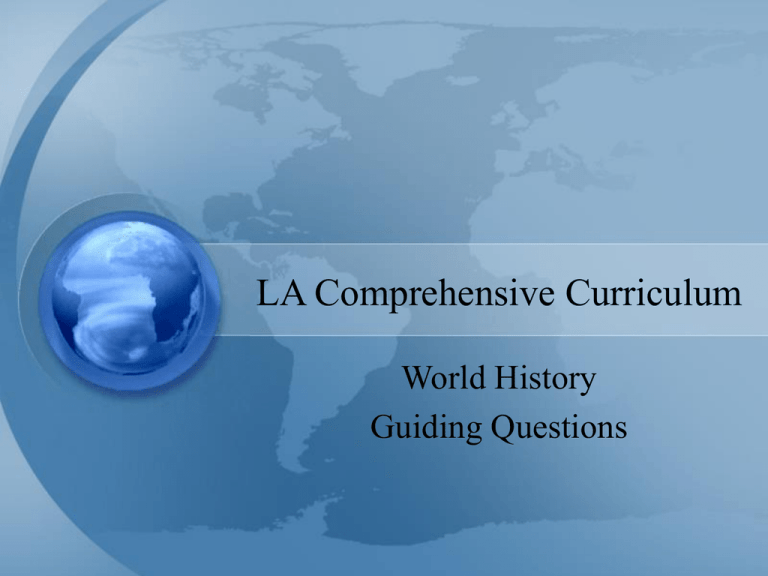LA Comprehensive Curriculum - Lafayette Parish School System
advertisement

LA Comprehensive Curriculum World History Guiding Questions Unit 1: Renaissance, Reformation, Scientific Revolution and Age of Enlightenment (1350-1770) 1. Can students identify demographic, economic, and social trends in major world regions? 2. Can students describe key features of the Renaissance, Reformation, Scientific Revolution, and the Age of Enlightenment? 3. Can students determine when primary and/or secondary sources would be most useful in analyzing historical events? Unit 1: Renaissance, Reformation, Scientific Revolution, and Age of Enlightenment (1350-1770) Continued 4. Can students define the term Renaissance and explain why the term was used to describe the historical period? 5. Can students explain the causes and effects of the Renaissance and its impact upon history then and now? 6. Can students explain the role the Renaissance spirit played in sparking the Scientific Revolution and the Age of Exploration? Unit 1: Renaissance, Reformation, Scientific Revolution, and Age of Enlightenment (1350-1770) Continued 7. Can students identify the major artistic, literary, and intellectual figures of the Renaissance and explain the significance of their achievements? 8. Can students describe the origin, causes, and effects of the Reformation? 9. Can students compare and analyze the beliefs and ideas of the leading Protestant reformers? Unit 1: Renaissance, Reformation, Scientific Revolution, and Age of Enlightenment (1350-1770) Continued 10. Can students summarize the reforms and the intent of the Roman Catholic Church’s Counter-Reformation? 11. Can the students identify the key players of the Scientific Revolution and analyze the impact of their discoveries on the world then and now? 12. Can students identify the key figures of the Age of Enlightenment? Unit 1: Renaissance, Reformation, Scientific Revolution, and Age of Enlightenment (1350-1770) Continued 13. Can students identify the significance of the key ideas expressed during the Age of Enlightenment? Unit 2: Exploration and Expansion (1450-1770) 1. Can students construct a timeline to explain and analyze historical periods in world history? 2. Can students analyze the point of view of an historical figure or group in world history? 3. Can students analyze or interpret a given historical event, idea, or issue in world history? Unit 2: Exploration and Expansion (1450-1770) Continued 4. Can students evaluate and use multiple primary or secondary materials to interpret historical facts, ideas, or issues? 5. Can students propose and defend alternative courses of action to address an historical or contemporary issue and evaluate their positive and negative implications? Unit 2: Exploration and Expansion (1450-1770) Continued 6. Can students conduct historical research using a variety of resources to answer historical questions related to world history and present that research in appropriate formats? 7. Can students analyze causes and effects in historical and contemporary world events, using a variety of resources? Unit 2: Exploration and Expansion (1450-1770) Continued 8. Can students explain the origins, developments, and consequences of the transatlantic slave trade between Africa and the Americas and Europe? 9. Can students identify major technological innovations in shipbuilding, navigation, and naval warfare and explain how these technological advances were related to European voyages of exploration, conquest and colonization? Unit 2: Exploration and Expansion (1450-1770) Continued 10. Can students identify demographic, economic, and social trends in major world regions? 11. Can students describe major changes in world political boundaries between 1450 and 1770 and assess the extent and limitations of European political and military power in Africa, Asia, and the Americas as of the mid-eighteenth century? Unit 2: Exploration and Expansion (1450-1770) Continued 12. Can students describe the development of nation-states and major world powers? 13. Can students describe the goals and consequences of European colonization in the Americas? 14. Can students describe the European commercial penetration of Asia and the impact on trade? Unit 2: Exploration and Expansion (1450-1770) Continued 15. Can students identify the influence of European economic power within Africa and its impact on other parts of the world? 16. Can students describe and evaluate the significance and possible consequences of major technological innovations and trends? Unit 3: Political Revolutions (17501914) 1. Can students construct a timeline to explain and analyze historical periods in world history? 2. Can students compare historical conflicts in terms of similar issues, actions, or trends in world history? 3. Can students interpret or analyze data in a map, table, or graph to explain historical factors or trends? Unit 3: Political Revolutions (17501914) Continued 4. Can students analyze or interpret historical events, ideas, or issues in world history? 5. Can students analyze causes and effects in historical and contemporary world events, using a variety of sources? 6. Can students describe the major ideas of philosophers and their effects on the world? Unit 3: Political Revolutions (17501914) Continued 7. Can students describe how the American Revolution differed from the French Revolution and the impact both had on world political developments? 8. Can students describe how the American Revolution differed from the French Revolution and the impact both had on world political developments? Unit 4: Agricultural, Commericial, and Industrial Revolution (1750-1914) 1. Can students describe the four major characteristics of the Agricultural Revolution that occurred in England and Western Europe and analyze its effects on population growth, industrialization, and patterns of landholding? 2. Can students explain the cause and effects of the Commercial Revolution and its impact on industrialization? Unit 4: The Industrial Revolution (1750-1914) Continued 3. Can students explain why the Industrial Revolution began in Englang? 4. Can students explain the causes and effects of the Industrial Revolution? 5. Can students describe the expansion of the Industrial Revolution to Western Europe, the U.S., and Asia? Unit 4: The Industrial Revolution (1750-1914) Continued 6. Can students describe the expansion of industrial economies and the resulting social transformations throughout the world? 7. Can students identify demographic, economic, and social trends in major world regions? Unit 5: Nations and Empires (1750-1914) 1. Can students describe the development of the nation-states of Italy and Germany? 2. Can students describe the motives, major events, and effects of Western European imperialism in Africa, Asia, and the Americas? 3. Can students use a map to identify the extent of European territorial expansion? 4. Can students use a map to identify the extent of American territorial expansion? Unit 5: Nations and Empires (1750-1914) Continued 5. Can students use a map to identify the extent of Japanese territorial expansion? 6. Can students interpret a political cartoon depicting imperialism? 7. Can students analyze causes and effects in historical and contemporary world events, using a variety of resources? Unit 6: Totalitarianism and Global Conflict (1900-1945) 1. Can students debate a historical point of view, with supporting evidence, on an issue or an event that occurred in World War I, the Great Depression, or World War II? 2. Can students interpret or analyze historical data in a map, table, or graph to explain historical factors or trends? 3. Can students explain the causes and the effects of World War I? Unit 6: Totalitarianism and Global Conflict (1900-1945) Continued 4. Can students describe the origins, major events, and peace settlements of World War I from multiple international perspectives? 5. Can students describe the causes and consequences of the Russian Revolution of 1917? 6. Can students explain how art, literature, and intellectual thought reflected changes brought about by World War I? Unit 6: Totalitarianism and Global Conflict (1900-1945) Continued 7. Can students explain the causes and consequences of global depression following World War I? 8. Can students describe the political, social, and economic conditions leading to the rise of totalitarianism in the Soviet Union, Germany, Italy, Japan, and Spain? 9. Can students describe the causes and effects of World War II? Unit 6: Totalitarianism and Global Conflict (1900-1945) Continued 10. Can students describe the origins, major events, and peace settlements of World War II, including important decisions made at wartime conferences? 11. Cans students explain the consequences of World War II as a total war? 12. Can students describe how the map of Europe was changed after World War I and World War II? Unit 7: Changing World of Superpowers (1945-Present) 1. Can students explain major differences in the political ideologies and values of the Western democracies versus the Soviet bloc and how they led to the development of the Cold War? 2. Can students describe the causes and effects of major Cold War crises and military conflicts and their effects on the world? Unit 7: Changing World of Superpowers (1945-Present) Continued 3. Can students analyze and compare the development of Communism in the Soviet Union and with that in China? 4. Can students describe the end of colonial rule in Asia, Africa, the Americas, and the Middle East? 5. Can students describe the role of the United Nations in the contemporary world? Unit 7: Changing World of Superpowers (1945-Present) Continued 6. Can students describe multiple perspectives on an historical issue or event in world history? 7. Can students analyze and evaluate the credibility of a given historical document in terms of its source or unstated assumptions? 8. Can students analyze source material to identify opinion or propaganda and persuasive techniques? Unit 7: Changing World of Superpowers (1945-Present) Continued 9. Can students construct a narrative summary of an historical speech or address? 10. Can students analyze the point of view of an historical figure or group in world history? 11. Can students interpret a political cartoon depicting an historical event, issue, or perspective? Unit 8: Contemporary World Trends and Issues (1945-Present) 1. Can students construct a timeline to explain and analyze historical periods in world history? 2. Can students interpret a political cartoon depicting an historical event, issue, or perspective? 3. Can students interpret or analyze historical data in a map, table, or graph to explain historical factors or trends? Unit 8: Contemporary World Trends and Issues (1945-Present) Continued 4. Can students analyze cause and effects in historical and contemporary world events, using a variety of resources? 5. Can students analyze the consequences of the breakup of the Soviet Union on the world? 6. Can students describe terrorist movements in terms of their proliferation and impact on politics and societies? Unit 8: Contemporary World Trends and Issues (1945-Present) Continued 7. Can students describe the progress and status of democratic movements and civil rights around the world? 8. Can students explain the political, social, and economic significance of growing interdependence in the global economy? 9. Can students describe and evaluate the significance and possible consequences of major technological innovations and trends? Unit 8: Contemporary World Trends and Issues (1945-Present) Continued 10. Can students analyze information about a current economic system undergoing change (e.g., command economy to mixed economy, traditional economy to industrial economy, developing countries to developed countries)? 11. Can students describe the role of the United Nations in the contemporary world? Created for use by social studies teachers in the Lafayette Parish School System.







